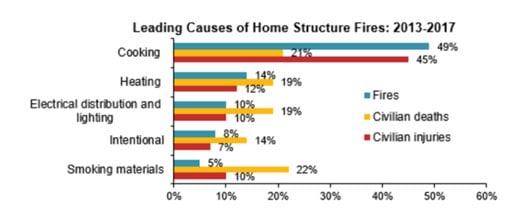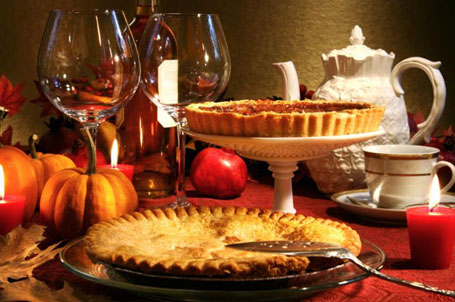
Fall Fire Prevention Campaign – Ideas and tips to help you minimize your risks for fires in your home
Why Cooking Safety Matters
Over the five-year period of 2013–2017 as a whole, cooking was the leading cause of home fires and home fire injuries, while smoking was the leading cause of home fire deaths.
-
 Cooking is the #1 cause of home fires and home fire injuries.
Cooking is the #1 cause of home fires and home fire injuries. - Unattended cooking is the leading cause of fires in the kitchen.
- Scald burns are the second leading cause of all burn injuries. Hot liquids from coffee and even microwaved soup can cause devastating injuries
“Cooking continues to be a major contributor to the home fire problem,” said Lorraine Carli, NFPA vice president of Outreach and Advocacy. “The good news is that the vast majority of these fires are highly preventable.”
 Carli noted that this year’s focus on cooking safety is particularly timely. “As the public may continue to avoid restaurants for some time and opt instead to do more cooking and entertaining at home, the potential for home cooking fires will likely increase as well.”
Carli noted that this year’s focus on cooking safety is particularly timely. “As the public may continue to avoid restaurants for some time and opt instead to do more cooking and entertaining at home, the potential for home cooking fires will likely increase as well.”
NFPA is promoting the following three guidelines:
- Keep a close eye on what you’re cooking; never leave cooking unattended
- Keep anything that can catch fire — oven mitts, wooden utensils, food packaging, towels or curtains — at least three feet away from your stovetop.
- Be on alert. If you are sleepy or have consumed alcohol, don’t use the stove or stovetop
You can find a checklist of cooking safety guidelines here. Be sure to share this with the younger members of your household!
6 Steps for Inspecting Home Fire Extinguishers
 Because extinguishers are only used in an emergency, regular inspections are the only way to confirm that they will work properly when needed. Regular inspections, however, can help to ensure that the canister remains in proper working order and ready in the event of a fire.
Because extinguishers are only used in an emergency, regular inspections are the only way to confirm that they will work properly when needed. Regular inspections, however, can help to ensure that the canister remains in proper working order and ready in the event of a fire.
Step 1: Ensure You Have Easy Access
Consider mounting clearly-visible fire extinguishers in these areas of your home:
- Outside of rooms containing furnaces, HVAC systems and water heaters
- Around fireplaces
- In the kitchen
- In the garage – be sure the extinguisher’s rated for cold temps if needed
- Outside near the grill or outdoor kitchen
Step 2: Check the Fire Extinguisher Inspection Tag
There’s a lot to look at when reviewing the condition of an extinguisher, and a great way to keep tabs on its upkeep is by reviewing the inspection tag. If it doesn’t come with one, make your own tag from cardboard for your notes/dates and attach to unit. Remember:Fire extinguishers only have about a 6 year life. They do expire and need to be replaced!
Step 3: Gauge the Pressure
Here’s what you need to know about your fire extinguisher’s charge (or pressure) gauge:
- The gauge’s needle should only point to the green “charged” zone
- An overcharged extinguisher could be an explosion risk
- An undercharged extinguisher may not be able to emit enough fire retardant to fight a fire
- The gauge should be checked monthly!
Step 4: Confirm the Hose and Pin Are in Place
The hose and pin are two key components that help to direct the chemical spray and prevent accidental discharge. In most cases, you’ll need to pull the safety pin to discharge the chemical, then point the hose at the fire before squeezing the handle to release the fire-fighting chemical.
If you find cracks in the hose, or if it’s too brittle to bend easily, get it replaced. Be sure the pin is securely tied to the extinguisher with a safety tether, if one was included originally. If the tether is missing, there’s a chance that the extinguisher has been used and the canister may not be completely full.
Step 5: Look for Physical Damage
When inspecting the extinguisher for damage, look for dents in the gas canister first. Scratches and divots in the paint can mean that it’s suffered a fall and may be leaking slowly. Rust around the seal between the canister and the neck can be another symptom of trouble.
Step 6: Update the Inspection Tag
After you’ve thoroughly reviewed the condition of the fire extinguisher, be sure to update the inspection tag with today’s date and any notes.
For more information, videos and a booklet on the use and care of fire extinguishers visit the NFPA website.
Electrical Safety self assessment checklist
Over the last thirty years, our home s have dramatically transformed by modern electrical devices have also contributed to the shocking number of electrical fires of this country suffers every year. Many existing homes are simply overwhelmed by today’s electrical demands, putting them at greater risk of so-called arc-faults and arc-induced fires.
Electrical fires do not have to happen. Use this checklist from ESFI to help you find and fix electrical fire hazards in your home before they can start a fire.
 Smoke Alarms – Smoke alarms save lives!
Smoke Alarms – Smoke alarms save lives!
- Do you have enough smoke alarms?
- Are they working?
- Do you test them?
Switches and Outlets – Be on the look-out for signs of trouble.
- Are they working?
- Do they make crackling, buzzing, or sizzling sounds?
- Are they warm to the touch?
- Do plugs fit snugly?
Cords – Never use damaged cords.
- Is there fraying or cracking?
- Are they pinched or pierced?
- Do you use extension cords all the time?
- Are cords getting enough air?
Lamps and Appliances – Use them safely.
- Are you using the right bulbs?
- Do you use space heaters safely?
- Are appliance cords protected from damage?
Electrical Panel – Know the basics.
- Do you have AFCIs?
- Have you tested your AFCIs?
- Are all circuit breakers and fuses the proper size?
Find more info on doing a self-assessment here
(Source: Electrical Safety Foundation International – ESFI)
HOME HEATING FIRE PREVENTION TIPS
 Heating equipment caused an estimated 50,500 home fires and 500 death between 2013 and 2017 according to the National Fire Protection Association. Learn how to stay safe with these tips.
Heating equipment caused an estimated 50,500 home fires and 500 death between 2013 and 2017 according to the National Fire Protection Association. Learn how to stay safe with these tips.
- Keep anything that can burn at least 3 feet from heat sources
- Never leave a space heater unattended. Turn off when leaving a room or sleeping
- Never plug a space heater into an extension cord
- Never use a cooking stove to heat your home or dry clothes
- Space heaters on level, flat surfaces on the ground
- Have a qualified service professional inspect your heating system annually
- Install and maintain carbon monoxide alarms
- Never use a space heater or any appliance with a damaged cord
 ESFI reminds you to keep electrical safety in mind as the cooler fall weather moves many activities back indoors. The following safety tips will help you stay safe during the change of seasons:
ESFI reminds you to keep electrical safety in mind as the cooler fall weather moves many activities back indoors. The following safety tips will help you stay safe during the change of seasons:
- Safely store warm weather tools like lawnmowers and trimmers. Check cold weather tools, such as leaf and snow blowers, along with their power cords, for unusual wear and tear. Repair or replace worn tools or parts right away.
- Unplug and safely store battery chargers that won’t be in use again until spring.
- Use only weatherproof electrical devices for outside activities. Protect outdoor electrical devices from moisture. Make sure wet electrical equipment is inspected and reconditioned by a certified repair dealer.
- Keep dry leaves swept away from outdoor lighting, outlets, and power cords.
- Make sure electric blankets are in good repair and certified by an independent testing lab such as UL, CSA, or ETL. Power cords should not be frayed, cracked, or cut.
- Do not tuck your electric blanket under mattresses or children, and do not put anything, such as comforters or bedspreads, on top of the blanket while it is in use.
- Never allow pets to sleep on an electric blanket.
(Source: Electrical Safety Foundation International)
When you experience a loss, the “intangible” promises in your auto or homeowner policy suddenly become very tangible! We understand the need for sensitive treatment and fast action. Fair and prompt payment of a loss settlement is our immediate goal.
This is the trust you placed in us when you chose the Keefe Insurance Agency. Maintaining your trust in these trying circumstances is a responsibility we take very seriously. Your complete satisfaction, if and when you have a claim, is our number one priority.

Wishing you and your family a safe and healthy Thanksgiving celebration!

